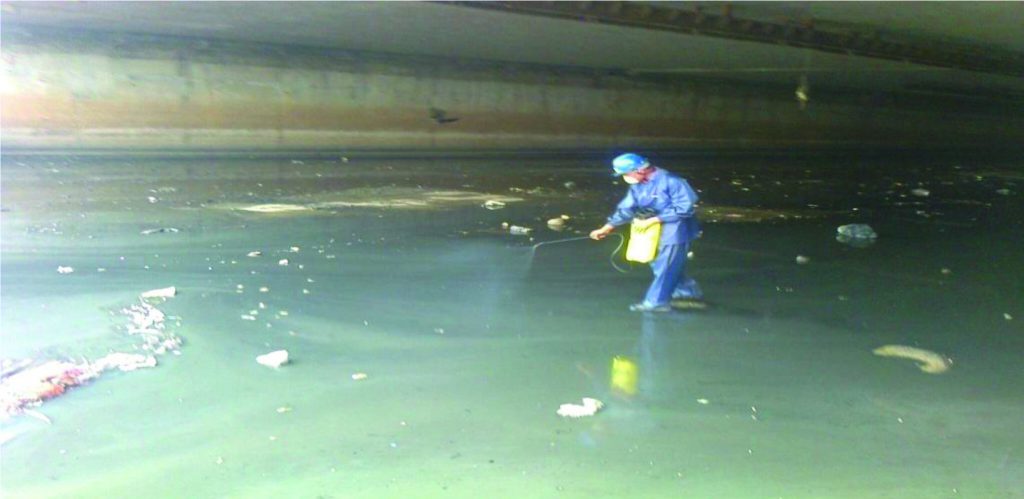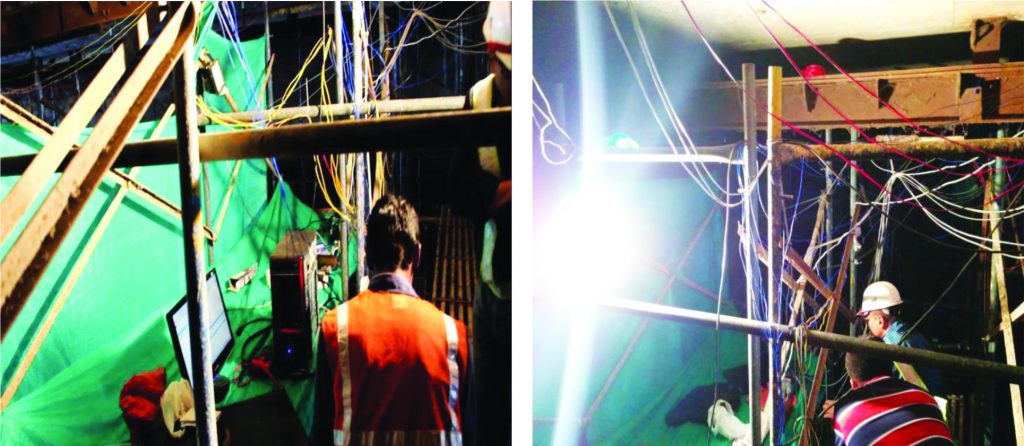| Dr. Gopal Rai Cheif Executive Officer, Dhirendra Group of Company (DGC) |
Since past few decades in structural health monitoring and rehabilitation techniques revolutionary development has occurred. Even after development of these techniques, many major issues and challenges are unsolved till now. This paper discusses about some of the common issues and challenges, which occurs during the structural health monitoring and rehabilitation. Issues and challenges faced during monitoring and retrofitting of Mithi river bridge of Mumbai airport has also been discussed as a case study.
Introduction
The health of structures is constantly affected and degraded throughout their service life by various kinds of factors, such as aging, fatigue, corrosion, and even natural disasters. The accumulated degradation will reduce the structures’ disaster resistance ability, and can sometimes lead to partial failure, failure, or even the complete collapse of the structures. The potential for such accidents is a direct threat to the safety of both lives and properties. With these rising concerns, health monitoring and rehabilitation technology of structures has become one of the top research focus areas in recent years. Despite the tremendous research done in the past few decades still there are major issues and challenges.
Structural Health Monitoring
Structural Health Monitoring (SHM) is the process of collecting, interpreting, and analyzing data from structures in order to determine its health status and the remaining life span. SHM is not a new concept, it’s already implemented on military aircraft with a different rationale but some converging features. The primary motivation for SHM is safety. The economic motivation is obvious too, which is possible by safety margins optimization in rehabilitation and retrofitting.
Motivation for Structural Health Monitoring
Knowing the integrity of in-service structures on a continuous real-time basis is a very important objective for manufacturers, end-users and maintenance teams. In effect, SHM:
- Allows an optimal use of the structure, a minimized downtime, and the avoidance of catastrophic failures
- Gives the constructor an improvement in his products
- Drastically changes the work organization of maintenance services by aiming to replace scheduled and periodic maintenance inspection with performance-based (or condition-based) maintenance (long term) or at least (short term) by reducing the present maintenance labour, in particular by avoiding dismounting parts where there is no hidden defect; by drastically minimizing the human involvement, and consequently reducing labour, downtime and human errors, and thus improving safety and reliability.
- The improvement of safety seems to be a strong motivation, after some spectacular accidents due to unsatisfactory maintenance and ill-controlled manufacturing process
Issues and Challenges in S.H.M.
While there might be numerous benefits of SHM, there are some challenges that need to be dealt with. The challenges faced by SHM system has been discussed by many researchers, which can be summarized as-
|
1) Large Scale Structure |
Fig.1: Steps of Structural Health Monitoring |
- Making strategies of selecting location for mounting the instrument to mounting the instrument at selected location.
- Acquiring data from the sensors.
- Maintaining and checking large number of sensors’ condition during complete duration of health monitoring.
- Handling the huge data from its collection to its processing and extracting results from it.
2) Huge Data Produced by Sensors
Though structure is of large or small scale the data produced by most of the health monitoring instruments and sensors are huge due to multiple number of locations and continuous monitoring of the structure. This huge data must be processed, and the most accurate and useful results should be extracted. Data analysis is still the key issue.
3) Site Conditions
The most frequently faced challenge during the health monitoring is adverse site conditions. Some of the common unfavourable site conditions are:
- Accessibility: In most of bridge cases the accessibility to the desirable location of the structure is difficult as the bridge is constructed to join the two inaccessible locations. In long span suspension bridge the bottom of the bridge deck is inaccessible and in closed girder bridge the girder’s inside part is difficult to instrument and mounting sensors and access.
- Environmental Factors: Harsh environment such as speedy wind, heavy rainfall or drastic changes in temperature disturb or damage the sensors.
4) Uncertainty and Reliability
Nevertheless, the acceptance of structural health monitoring techniques as a standard tool for assessing the actual structural conditions and reducing uncertainties in a performance-based life-cycle design approach is still a matter of discussion and further research is needed before it will spread in engineering practice. Diagnosis must have high reliability over the structure’s lifetime, since un-justified maintenance actions are quite costly to the operator and spurious warnings degrades confidence in the system. Accuracy and reliability may even be more stringent since further optimization of structural design is based on SHM. There are still many unresolved problems to study, but the main issue is concerning the uncertainties residing in the logical process that can be constructed to determine the actual structural reliability from the monitoring data. The sources of uncertainty that are involved in this process are related to:
- The type, number and location of sensors with respect to the location of the structural change.
- The sensitivity of the measured parameters with respect to the intensity of the change.
- The calibration and tolerance of instruments and sensors.
- The measurement errors.
- The dependability of the data transmission and storage systems.
- The ability of the data processing algorithms in identifying the changes with an acceptable level of confidence.
- The availability of a reasoning paradigm for updating with an acceptable level of confidence a structural reliability measure based on the identified changes.
- The most fundamental challenge is the fact that damage is local phenomenon, whereas SHM system typically detects global damage and thus the damage might go undetected.
- The final health monitoring results are sometimes inconclusive.
5) Cost
One of the primary challenges for SHM is cost, it should not exceed the benefits gained or not to be too prohibitive so that mass adaption slows down or halts. The constraint of structural safety certification and the existing cost/benefit have limited introduction commercially in construction. SHM is still in transition from a research topic to becoming an industry norm. SHM delays and disturbs the new construction and it disturbs the smooth service of the structure when the monitoring is taking place during service life of the structure. Structural system owners need to be convinced of the economic benefits over current maintenance approaches.
Structural Rehabilitation and Retrofitting
Structural rehabilitation involves the upgrading or changing of a building’s foundation in support of changes in the building’s owners, its use, design goals or regulatory requirements. In every case it is determined that it is cheaper to rehabilitate the structure and make the building improvements instead of demolishing and constructing a new building in the allotted space.
The engineering that involves in modifying the existing buildings for structural behaviour without hampering its basic intent of use is termed as retrofitting. It becomes necessary to improve the performance of structures including those facing loss of strength due to deterioration or which have crossed their anticipated lifespan. The realization of retrofitting depends on the authentic cause and measures adopted to prevent its further deterioration. This development includes repair, retrofit, renovation and reconstruction wherever required. A proper load path must be analysed by a structural engineer and a decision must be taken if any additional element like shear wall, etc. needs to be added.
Some of the basic reasons of retrofitting any structure will be:
- Preservation
- Functional changes
- Raising additional storeys
- Construction of underground levels
- Mistakes in the design and construction process
- Modifications carried out improperly
- Damages
- Reduction of the bearing capacity for seismic and gravity loads.
Issues and Challenges in Rehabilitation and Retrofitting
1) Site Condition
In retrofitting and rehabilitation, the most common execution site challenges are narrow space and accessing difficulties. The detailed site condition challenges are discussed and explained further in this paper with the help of a Case Study. Some of the frequent site challenges for retrofitting are as follows:
- Unfavourable environmental conditions
- Site Congestion or accessibility problem
- Structure is in under-function, which creates obstruction to easiness and speed of retrofitting work.
2) Insufficient Data
For proper rehabilitation and retrofitting design work complete design, drawing and material data are required. When rehabilitation and retrofitting of old structures are considered, insufficient data is the most common issue that is faced.
| Fig.2: Position of Mithi River Bridge below the Runway |
Case Study: Mumbai Airport Runway BridgeThe bridge under consideration is the one at the Mumbai Airport, over the Mithi River. The bridge structure is a reinforced concrete structure, earlier designed for smaller aircrafts. But the bridge won’t be enough to carry the loads of the current design of aircrafts (Fig. 2). Hence a need for strengthening the bridge arose and considering all the available techniques, FRP laminate bonding was suggested. This was in view with the overall repair costs and anti-corrosion properties of the FRP materials. The structural health monitoring was also carried out before and after the retrofitting work. Different troublesome site challenges were faced during both monitoring and retrofitting work. |
Challenges at Site
1) During the execution of the Phase I of Monitoring the water level in the Mithi River had abruptly gone up due to the rains experienced due to the retreating monsoon in the month of November. The planned work was delayed due to the same, considering the safety of men and material. The primary major problem was of erection of scaffolding due to heavy sludge and water clogging. In the rainy season the water level was high. The entire six compartments had standing muddy water. Due to the presence of the water, the electric cable with Halogen could not be taken inside as any leakage would have resulted in electrocution of the personnel inside. Survey was carried out using battery operated torch lights.
|
Fig 3: Water Clogged in Box Girder
|
|
2) A Heavy-duty exhaust fan and blower was employed to take out the foul smell and induct fresh air inside the tubes due to the sludge and low ventilation. As the monitoring and retrofitting work was carried out inside the box girder there was severe problem of ventilation. Due to sludge and low light and ventilation condition, too many insects were there making execution difficult.
| Fig 4: Pest Control for Insect Issue |
3) Due to congestion and low ventilation, breathing issue arose for which carrying of oxygen cylinders became necessary. 4) Continuous light arrangement provision was necessary. 5) As project is of large scale and too many sensors were placed in 3 bays at the same time, number of wiring and connection of sensors at congested place was large and difficult to handle |
|
Fig 5: Site Congestion |
|
|
Fig 6: Wiring of Sensors near Data Acquisition Arrangement in Congested Site Area
|
|
6) The site was too congested that hardly one metre working height was available for monitoring and retrofitting execution.
7) Ultrasonic Pulse Velocity (UPV) equipment was used to determine the depth of the crack. However, the result of the UPV was inconclusive.
Conclusion
An overview of issues and challenges discussed in this paper are not purely technical but circumstantial. Therefore, the general common solution can’t be provided but with development and encouraging research in this field the improved methods and technologies can minimizes the issues and challenges.
References
- Abid Ali Khan, et. al.2014. “History, Current Status and Challenges to Structural Health Monitoring.” Journal of Space Technology Vol-4, No-1.
- Muhammad Khairi et al., 2017. “The application, benefits and challenges of retrofitting the existing buildings” IOP Conference Series: Materials Science and Engineering.
- R&M International, 2014. “Report for strengthening of Mithi River Bridge under Mumbai Airport Runway.”










